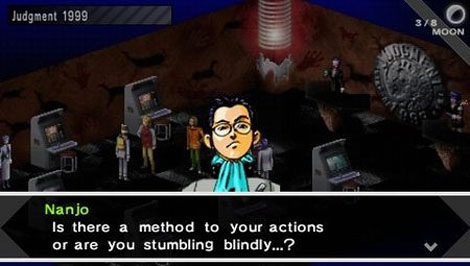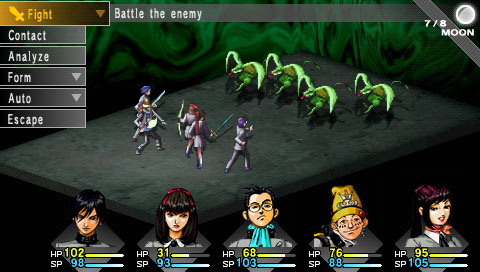To be clear, I am referring to the PSP remake of the game
because that is the one you’ll play unless you go out of your way to prove that
statement wrong, but you’ll be cutting yourself down a few hundred
dollars. Not only is the original PS1
version rare, but not even Atlus wants people to play that version. The original game is notorious for its
localization trying to change characters and settings to be American, resulting
in some pretty ugly aesthetics on top of already very dated FMV sequences and
poor voice acting (what little there was).
It also cut out an entirely separate chapter from the original Japanese
version so it’s about on the level of Devil Kings with how embarassing it is. Unlike Devil Kings, however, the translated
script is mostly accurate aside from name changes so it wasn’t a total bust,
but Atlus is not proud of it and thus has not released the original PS1 version
on PSN.
 |
| Some dialogue came off a little unnatural, however. |
The PSP remake, on the other hand, is on PSN for 20 dollars
for your Vita and PSP. The remake cleans
up the graphics a bit, has a new interface, tweaks some of the worse combat
faults (like debuff stacking), adds a brand new soundtrack more in line with
the later games, adds new FMV scenes that actually look good and, most
prominently, completely redoes the sloppy localization and keeps in all the
content. That is the version you will
play. As for why you would want to play
it, I can count the ways.
1. Simpler Story
I love a good, complex story with multiple plot threads,
individual character stories and a rogue’s gallery of different villains with
their own agendas, but sometimes a story just needs one good focus to grow
from, which Persona does very well. The
main story of the game has one easy goal it establishes: beat Kandori. You run into monsters, deal with the
mysterious girl in black and meet strange people in another world, but there’s
always a sense of purpose when the clear end goal is to get to that mofo and
beat him down to save the town. In other
JRPGs, the heroes deal with things as they come or the plot moves around so
much the goal is ever-changing. Like I
said, I love those stories, but it can be nice to take it down a peg and have
something easier to follow.
 |
| Philemon is a good example of an exposition man done right. |
2. Characterization Through Gameplay
The main story does a serviceable job establishing
characters, but a lot of the fun comes from simpler dialogues. Whenever you enter a room outside of an
exploration area, your teammates are there with you to chat with, often giving
the thoughts on the situation or their locations. The dialogue changes as the story progresses
so there’s always something new to say.
Casually talking as we’re on an adventure or shopping feels natural and
the characters are so relatable and likeable that the dialogue itself is
entertaining. It being optional also
means it’s enjoying the game at your own pace.
Not a lot of games have this kind of detail in idle chitchat anymore.
 |
| Hush. I'm betting my life savings. |
The dialogue extends into battle as well. Every character has sets of unique dialogue
for their demon negotiation options, each of which correspond to their
character. Mark is a laid-back braggart
so he can dance crazy, brag and stare, while noble rich boy Kei can bribe,
pontificate and use sarcasm. It’s
another layer of characterization how everyone uses their personalities in
their own special ways to negotiate with demons, which is done much better here
than in other SMT games.
3. Decent Demon Negotiation
I loved Shin Megami Tensei 4, but the demon negotiation was
one of its weakest points. Every single
one was a complete shot in the dark.
There was little consistency in what worked and no indication of whether
you were doing it right or close to recruiting them.
In Persona, there’s a very useful grid in the corner of the
screen showing if they’re mad, sad, happy or persuaded to join that lets you
see what’s working and what’s not.
What’s more, a lot of demons have dialogue specific to them or their
type instead of a pool of generic language to make negotiating feel a bit more
personal with them. Since the demons in
Persona have consistent reactions (give or take a moon phase), battles can be
made much easier and you can keep talking demons into giving you stuff instead
of fighting them. That combined with the
aforementioned characterization makes negotiating with demons a fun gameplay
mechanic.
 |
| Bad translation meme kept for fun. |
4. Good music
I bought the soundtrack.
5. Good Pacing
I don’t like it when a game’s plot developments have too
little dialogue like Chrono Trigger, nor do I like it when it has too much like
Blazblue Chronophantasma and, at times, Persona 4. Persona has the right balance. Dialogue never overstays its welcome and the
story is firmly established enough to be fulfilling. There's not much to say except not that many games get it right.
6. Quick combat
As much as I like the game, it is let down by its random
encounters. A lot of the game is spent
fighting enemies. That really kills the
original version, but in the PSP version is the super-duper amazing godsend
known only as the skip command. All you
have to do is press start and combat goes on fast forward, skipping the more
complex animations like persona summoning and potentially ending battles in
seconds. I like to turn it off for boss
battles and the occasional new enemy, but it’s best left on when you’re blowing
through a dungeon.
The skip command is the biggest contributing factor, but the
game also has enough to work with to make efficient use of your time. Getting through dungeons as fast as you can
is like a puzzle of finding the things in negotiations that make demons go away
and finding out ways to kill them quickly when you have to. Maybe that wasn’t intentional, since that
makes the goal to get a particular part of the game out of the way, but it’s
another layer of gameplay to me. If
you’ve played Final Fantasy 6 you’re already used to the pace of the random
encounters.
7. Two Stories, One Game
The main plot is decent enough on its own, but Persona has
an entirely different plot you can get into with almost as much effort put into
it that lets you use a new party and learn more about the non-playable high
schoolers. It has new environments, new
music, a new challenge in timed dungeon crawling and a new villain, giving a sizable bonus to an already nice game. In a game
today, the second plot would be a DLC story you’d have to pay for. Not that that’s inherently a bad thing,
because that should mean the focus was put on the main story before adding some
more content. Unless of course they put
it in the game coding when you already bought it and only let you use it if
you pay for it, but when has Atlus ever been that much of an abhorrent fucking
asshole.
8. Balanced Difficulty
Persona 3 and 4 had a good balance of challenge. They weren’t too hard if you knew what you
were doing, but one of the satisfying aspects is figuring out what you’re
doing. The Persona remake follows
suit. There’s a fair number of save
points, shops have what you need and bosses can be challenging and exciting
without being unfair.
Until the final boss!
The final boss of the main story, specifically its final
form, is awful! After spending at least
an hour going through a long maze filled with floor traps and powerful monsters
you’ll blow some of your items on, you enter a battle of attrition with a boss
with high defense and over triple the health of the other bosses with the
ability to totally wipe out your party, move twice and change weaknesses before
you can call off any attack! It is
unfair, infuriating, tedious and seem to be designed solely to waste your time
and test your patience!
As bad as that is, I won’t let a bad ending ruin the entire
game for me when everything up to that point was good. It’s a pleasant surprise for me when I go
into an old game reputed to be archaic and then find it to be one of the better
examples of the genre. That’s not to say
Persona still doesn’t have some archaic design choices, even in the
remake. The grid-based system for attack
range seems unnecessary, a couple of the dungeon designs can go straight to
hell, you’ll want a guide for a few points and even though it’s fun to find out
how to breeze through them, the random encounters can get on your nerves in
extended play periods. At times it’s
definitely one of those games you’ll want to play while you’re watching TV or something. However, all these issues have been in other
higher-regarded JRPGs so Persona deserves a fair shake too. It won’t take up much space on your Vita
memory cards (about half a gigabyte) so I urge my readers to try it if you have the system for it.


No comments:
Post a Comment